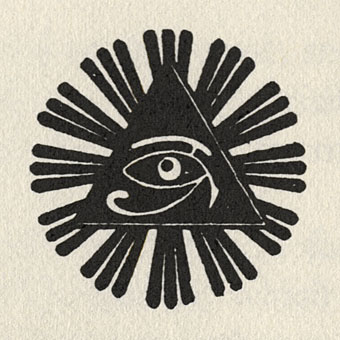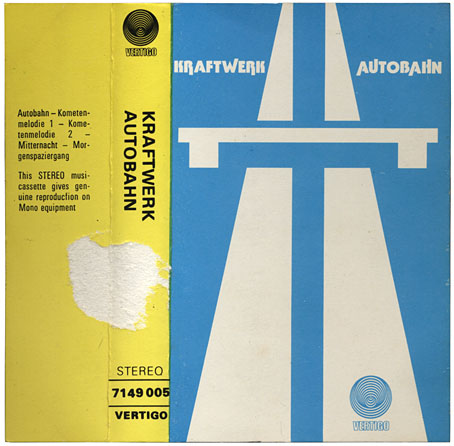End of the road for Kraftwerk founder | Florian Schneider leaves Kling Klang.
Tag: Kraftwerk
Speak & Spell
Before speech synthesis became a standard feature of home computing there was this crude device for teaching children spelling, now emulated in Flash by Kevin St. Onge. Anyone who’s heard Kraftwerk’s later music will recognise the tones generated by the top row of buttons which Ralf and Florian used on the track Home Computer for the Computer World album. Speak & Spell voices turned up on many recordings throughout the Eighties and Nineties. Fun as this emulator is I’d much prefer an EMS VCS3 to play with.
Previously on { feuilleton }
• Old music and old technology
• A Clockwork Orange: The Complete Original Score
• Aerodynamik by Kraftwerk
• The genius of Kraftwerk
Design as virus 7: eyes and triangles

Continuing this occasional series. The above motif is the Golden Dawn’s Wedjat or Eye of Horus emblem as reproduced in the hardback edition of The Confessions of Aleister Crowley, an “autohagiography”. Crowley was under discussion here a few days ago and the eye in a triangle symbol can also be seen on the sleeve of the single featured in that posting, forming a part of the seal of the Ordo Templi Orientis, the occult order which Crowley joined in 1910. Crowley’s use of the eye in a triangle caught the attention of writer Robert Anton Wilson and the first part of his Illuminatus! trilogy (written with Robert Shea) is titled The Eye in the Pyramid. That latter symbol appears on the reverse of the American dollar bill, of course, and some of the conspiracy theories surrounding that usage are explored in the novel. Wilson went on to make the eye in a triangle something of a personal symbol and his obsessive use of the motif caught my attention in turn when I began reading his books.
All of which leads us to Hawkwind and a person whose name keeps turning up on these pages, designer Barney Bubbles.

Hawklog cover (detail) by Barney Bubbles.
The booklet which BB designed for Hawkwind’s second album, In Search of Space (1971), featured a version of the dollar bill symbol on its cover. This is the only eye in a triangle design I’ve seen among Barney Bubbles’ work although he was so prolific there may well be others. When I began producing my own significantly inferior Hawkwind graphics in the late Seventies I incorporated eyes in triangles partly as a way of avoiding having to draw hawks all the time but mainly because of Robert Anton Wilson. BB had already established a precedent and it so happens that the eye in the Golden Dawn/Crowley version is the eye of a hawk-headed Egyptian god.
Old music and old technology

Clearing junk today turned up some obsolete artefacts one of which (the Kraftwerk) has been kept for purely sentimental reasons. It’s been amusing the past few years watching the vinyl disc refuse to crawl onto the scrapheap of history despite its death having been announced many times over by journalists who should know better. Several of the CD releases I’ve designed recently have also been brought out in vinyl editions. Meanwhile the audio cassette really is on the way out: “Sales of music cassettes in the U.S. dropped from 442 million in 1990 to about 700,000 in 2006” says Wikipedia. I certainly won’t mourn its passing; portability aside, I always hated these things. Music sounded shitty unless the tape was chrome or some other high-quality format, and whatever the quality they were all subject to mangling by cheap cassette players.
A Clockwork Orange: The Complete Original Score
CBS 73059; construction by Karenlee Grant, photo by David Vine (1972).
A1 Timesteps (13:50)
A2 March From A Clockwork Orange (7:00)
B1 Title Music From A Clockwork Orange (2:21)
B2 La Gazza Ladra (5:50)
B3 Theme From A Clockwork Orange (1:44)
B4 Ninth Symphony: Second Movement (4:52)
B5 William Tell Overture (1:17)
B6 Country Lane (4:43)
Viddy well the stuff of obsessions, O my brothers: Kubrick, cover design and electronic music in one convenient 12-inch package. Those of us in Britain who were too young to see A Clockwork Orange during its initial run had to wait a long time for its re-release after Stanley K withdrew the film from circulation. Until bootleg VHS copies started to turn up in the 80s I knew the film mostly from the MAD Magazine parody and the soundtrack album which was ubiquitous in secondhand record shops. Having become familiar with the score, an additional layer of frustration was added when it became apparent that two soundtrack albums had appeared in the 1970s, the “official” one, which was a mix of the orchestral and electronic music used in the film, and another which contained all the music Walter (later Wendy) Carlos recorded.
The Wendy Carlos music was the principal attraction for this electronic music obsessive and I fretted for a long while trying to find a copy of her Complete Original Score album which was paraded in all its elusive glory on old CBS vinyl inner sleeves. Half the tracks are present on the official release but the omissions are crucial: Timesteps, the incredible composition which accompanies Alex’s first deprogramming session was edited down from thirteen to five minutes, there was Carlos’s Moog version of Rossini’s La Gazza Ladra (an orchestral version is used in the film) and also an original piece, Country Lane, intended to accompany Alex’s police brutality session at the hands of his former droogs. The score was one of the first projects to successfully incorporate a vocoder into electronic compositions; Rachel Elkind, Carlos’s regular collaborator, provided the vocalisations. Finally securing a copy was no disappointment, in fact I was overwhelmed. This is still my favourite Wendy Carlos album and one of my top five favourite analogue synth albums. The transcription of La Gazza Ladra is nothing short of miraculous, thundering away with the power of a full orchestra yet created by laboriously recording one note at a time. (Wendy Carlos’s very thorough website goes into detail about the recording process.)
Continue reading “A Clockwork Orange: The Complete Original Score”


